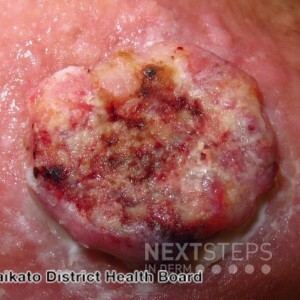
The correct answer is A. Transition.
The diagnosis in this case is squamous cell carcinoma which is most commonly due to chronic sun exposure. UV light produces DNA damage that, if unrepaired, can cause a mutation via base substitution due to mispairing during S phase of the cell cycle. Pyrimidine dimers are formed when 2 adjacent pyrimidines are fused. If uncorrected prior to replication, UV light mainly lead to Cytosine (C) → Thymine (T) transitions which are also known as UV signature mutations.
A transition mutation is a change from a pyrimidine to a pyrimidine (C, T). UV light (especially UVA) can also create Guanine (G) →T and T→G transversions with 8-oxo-7,8-dihydroguanine (8-oxoG), but these are not UV signature mutations. A transversion mutation is a change from a purine(2 rings) to a pyrimidine(1 ring), or vice versa. UV signature mutations are C→T transitions, not termination mutations. UV can form cyclobutane pyrimidine dimers which are the most common DNA photoproducts in the skin. Pyrimidine dimers can lead to UV signature mutations, but they themselves are not UV signature mutations because they do not contain C→T transitions.
References:
Rünger TM: C to T transition mutations are not solely UVB-signature mutations, because they are also generated by UVA.J Invest Dermatol 2008; 128: pp. 2138-2140.
Farzan SF, Waterboer T, Gui J, et al. Cutaneous alpha, beta and gamma human papillomaviruses in relation to squamous cell carcinoma of the skin: a population-based study. Int J Cancer. 2013;133(7):1713-20.
Maguire B, Smith NP. Histopathology of cutaneous squamous cell carcinoma. Clin Dermatol. 1995;13(6):559-568. doi:10.1016/0738-081x(95)00161-8
Kim JYS, Kozlow JH, Mittal B, et al. Guidelines of care for the management of cutaneous squamous cell carcinoma. J Am Acad Dermatol. 2018;78(3):560-78.
